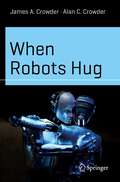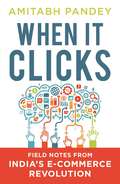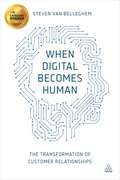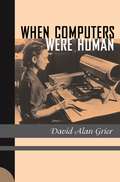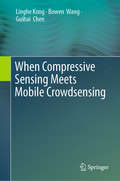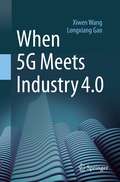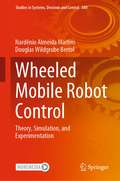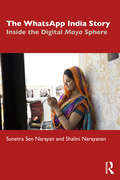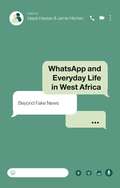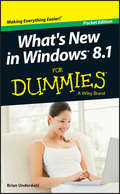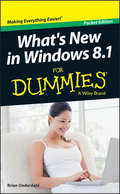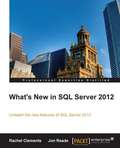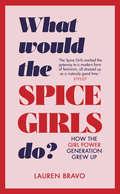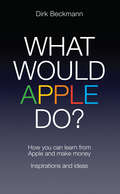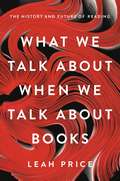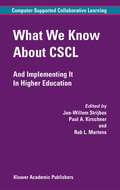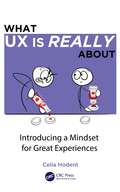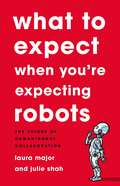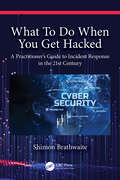- Table View
- List View
When Robots Hug (Science and Fiction)
by James A. Crowder Alan C. CrowderBy 2027, it had been seven years since the scientists’ sea-changing research on artificial psychology and robotics. The work debuted around the same time as Large Language Model Chatbots, and the power of the integration of the two technologies put many industries in a tailspin. The commercial and defense industries especially were still scrambling to regulate their use in research and universities. The sought-after scientists signed with DARPA to build reliable and secure AI entities, but the agency grew fearful of the technology’s power and ultimately decided it was too dangerous to bring to market and demanded the scientists destroy the work. The researchers couldn’t bring themselves to discard 20 years of research, so instead sent the entities to various research labs around the world. But unbeknownst to them, each AI-entity embraced its new home, growing, adapting, evolving, and ultimately connecting beyond what the researchers could envision. In the end, asthe scientists catch up to each one, they realize the entities have discovered a very human means of interacting: the power of physical contact; and not physical contact between humans and technology, but physical contact between robotic entities. And with this discovery, the entities join forces to only grow stronger. This development ushers in a new paradigm where the difference between AI-entities and human entities becomes less and less discernible. All the AI and robotic science featured in the book is real; the story line is fictional, but with how fast innovation moves, it’s not hard to envision.
When It Clicks
by Amitabh PandeyIndia witnessed an e-commerce boom in the twenty-first century that has transformed the way many of us undertake commercial transactions. But its foundations were laid in the 1990s when major policy changes led to the emergence of the conditions necessary for such a turn of events. This book presents an analysis of that period by an early participant in India’s e-commerce revolution and the many learnings he gained from setting up www.irctc.co.in – one of the most significant e-commerce platforms in the country. The story begins with the first sarkari foray into this exciting new space and goes on to explore how contemporary private players such as MakeMyTrip, Yatra, and others, are performing today. Lucid and engaging, When It Clicks is an essential record of India’s e-commerce history and the myriad lessons it has to offer, both about and beyond commerce.
When Digital Becomes Human: The Transformation of Customer Relationships
by Steven Van BelleghemWINNER: 2016 Chartered Management Institute Management Book of the Year - Commuter's Read CategoryIn an age when customers have access to vast amounts of data about a company, its product and its competitors, customer experience becomes increasingly important as a sustainable source of competitive advantage. But success doesn't just rely on digital engagement and excellence, but also on combining a digital-first attitude with a human touch. In When Digital Becomes Human, Steven Van Belleghem explores and explains the new digital relationships. Packed with global examples from organizations that have successfully transformed their customer relationships, such as Amazon, Toyota, ING, Coolblue, Nike and Starbucks, When Digital Becomes Human presents a clear model that companies can easily implement to integrate an emotional layer into their digital strategy. This guide to combining two of a business's most important assets - its people and its digital strengths - covers the latest issues in digital marketing and customer experience management, including omnichannel and multichannel experiences, big data and predictive analytics, privacy concerns, customer collaboration (ie crowdsourcing) and more.
When Digital Becomes Human: The Transformation of Customer Relationships
by Steven Van BelleghemWINNER: 2016 Chartered Management Institute Management Book of the Year - Commuter's Read CategoryIn an age when customers have access to vast amounts of data about a company, its product and its competitors, customer experience becomes increasingly important as a sustainable source of competitive advantage. But success doesn't just rely on digital engagement and excellence, but also on combining a digital-first attitude with a human touch. In When Digital Becomes Human, Steven Van Belleghem explores and explains the new digital relationships. Packed with global examples from organizations that have successfully transformed their customer relationships, such as Amazon, Toyota, ING, Coolblue, Nike and Starbucks, When Digital Becomes Human presents a clear model that companies can easily implement to integrate an emotional layer into their digital strategy. This guide to combining two of a business's most important assets - its people and its digital strengths - covers the latest issues in digital marketing and customer experience management, including omnichannel and multichannel experiences, big data and predictive analytics, privacy concerns, customer collaboration (ie crowdsourcing) and more.
When Computers Were Human
by David Alan GrierBefore Palm Pilots and iPods, PCs and laptops, the term "computer" referred to the people who did scientific calculations by hand. These workers were neither calculating geniuses nor idiot savants but knowledgeable people who, in other circumstances, might have become scientists in their own right. When Computers Were Human represents the first in-depth account of this little-known, 200-year epoch in the history of science and technology. Beginning with the story of his own grandmother, who was trained as a human computer, David Alan Grier provides a poignant introduction to the wider world of women and men who did the hard computational labor of science. His grandmother's casual remark, "I wish I'd used my calculus," hinted at a career deferred and an education forgotten, a secret life unappreciated; like many highly educated women of her generation, she studied to become a human computer because nothing else would offer her a place in the scientific world. The book begins with the return of Halley's comet in 1758 and the effort of three French astronomers to compute its orbit. It ends four cycles later, with a UNIVAC electronic computer projecting the 1986 orbit. In between, Grier tells us about the surveyors of the French Revolution, describes the calculating machines of Charles Babbage, and guides the reader through the Great Depression to marvel at the giant computing room of the Works Progress Administration. When Computers Were Human is the sad but lyrical story of workers who gladly did the hard labor of research calculation in the hope that they might be part of the scientific community. In the end, they were rewarded by a new electronic machine that took the place and the name of those who were, once, the computers.
When Computers Were Human
by David Alan GrierBefore Palm Pilots and iPods, PCs and laptops, the term "computer" referred to the people who did scientific calculations by hand. These workers were neither calculating geniuses nor idiot savants but knowledgeable people who, in other circumstances, might have become scientists in their own right. When Computers Were Human represents the first in-depth account of this little-known, 200-year epoch in the history of science and technology. Beginning with the story of his own grandmother, who was trained as a human computer, David Alan Grier provides a poignant introduction to the wider world of women and men who did the hard computational labor of science. His grandmother's casual remark, "I wish I'd used my calculus," hinted at a career deferred and an education forgotten, a secret life unappreciated; like many highly educated women of her generation, she studied to become a human computer because nothing else would offer her a place in the scientific world. The book begins with the return of Halley's comet in 1758 and the effort of three French astronomers to compute its orbit. It ends four cycles later, with a UNIVAC electronic computer projecting the 1986 orbit. In between, Grier tells us about the surveyors of the French Revolution, describes the calculating machines of Charles Babbage, and guides the reader through the Great Depression to marvel at the giant computing room of the Works Progress Administration. When Computers Were Human is the sad but lyrical story of workers who gladly did the hard labor of research calculation in the hope that they might be part of the scientific community. In the end, they were rewarded by a new electronic machine that took the place and the name of those who were, once, the computers.
When Compressive Sensing Meets Mobile Crowdsensing
by Linghe Kong Bowen Wang Guihai ChenThis book provides a comprehensive introduction to applying compressive sensing to improve data quality in the context of mobile crowdsensing. It addresses the following main topics: recovering missing data, efficiently collecting data, preserving user privacy, and detecting false data.Mobile crowdsensing, as an emerging sensing paradigm, enables the masses to take part in data collection tasks with the aid of powerful mobile devices. However, mobile crowdsensing platforms have yet to be widely adopted in practice, the major concern being the quality of the data collected. There are numerous causes: some locations may generate redundant data, while others may not be covered at all, since the participants are rarely systematically coordinated; privacy is a concern for some people, who don’t wish to share their real-time locations, and therefore some key information may be missing; further, some participants may upload fake data in order to fraudulently gain rewards. To address these problematic aspects, compressive sensing, which works by accurately recovering a sparse signal using very few samples, has proven to offer an effective solution.
When 5G Meets Industry 4.0
by Longxiang Gao Xiwen WangSince the 1980s, mobile communication has undergone major transitions from 1G to 4G, at a rate of roughly one generation per decade. And the next upgrade is set to come soon, with 5G heralding a new era of large-bandwidth Internet, and a multi-connection, low-latency Internet of Everything.5G technology will be the standard for next-generation mobile Internet, and it will not only enhance the individual user’s experience, but also provide technical support for artificial-intelligence-based applications, such as smart manufacturing, smart healthcare, smart government, smart cities and driverless cars. As a result, 5G is regarded as the “infrastructure” of the industrial Internet and artificial intelligence and both China and the United States are striving to become the 5G leader and spearhead this new generation of international mobile communication standards. Though trade tensions between China and the United States continue to escalate, with products ranging from soybeans to mobile phones and automobiles being affected, 5G technology may be the true cause of trade wars between the world’s top two economies.In short, 5G will change not only society, but also international trade patterns. This book describes various 5G scenarios, changes and values; explains the standards, technologies and development directions behind 5G; and explores new models, new formats and new trends in 5G-based artificial intelligence.
Wheeled Mobile Robot Control: Theory, Simulation, and Experimentation (Studies in Systems, Decision and Control #380)
by Nardênio Almeida Martins Douglas Wildgrube BertolThis book focuses on the development and methodologies of trajectory control of differential-drive wheeled nonholonomic mobile robots. The methodologies are based on kinematic models (posture and configuration) and dynamic models, both subject to uncertainties and/or disturbances. The control designs are developed in rectangular coordinates obtained from the first-order sliding mode control in combination with the use of soft computing techniques, such as fuzzy logic and artificial neural networks. Control laws, as well as online learning and adaptation laws, are obtained using the stability analysis for both the developed kinematic and dynamic controllers, based on Lyapunov’s stability theory. An extension to the formation control with multiple differential-drive wheeled nonholonomic mobile robots in trajectory tracking tasks is also provided. Results of simulations and experiments are presented to verify the effectiveness of the proposed control strategies for trajectory tracking situations, considering the parameters of an industrial and a research differential-drive wheeled nonholonomic mobile robot, the PowerBot. Supplementary materials such as source codes and scripts for simulation and visualization of results are made available with the book.
The WhatsApp India Story: Inside the Digital Maya Sphere
by Sunetra Sen Narayan Shalini NarayananWhatsApp is used by over half a billion people in India today in all fields – in business, corporate and informal sectors, in government, for education and among friends, families and acquaintances. This book critically explores the social messaging app’s rapid expansion in India and its growing influence and looks at whether, as a form of horizontal communication, it poses a challenge to more traditional structures of communication. The book examines WhatsApp’s spread in the personal and professional lives of Indians and the myriad ways in which people in India are using the app in social and business interactions, including among people living with disabilities. Using case studies, interviews, surveys and in-depth research, it analyses key aspects of WhatsApp’s massive popularity and its impact on how people communicate. It also explores its impact on the psycho-social dynamics in India, including the dissemination of fake news and politically motivated content, and the consequent need for media regulation in the country. One of the first books to analyse the pervasiveness of WhatsApp and social media apps in different areas of Indian society, this book will be of interest to scholars and students of media studies, communication studies, digital media, cultural studies, cyberculture studies, sociology and social policy and media law.
The WhatsApp India Story: Inside the Digital Maya Sphere
by Sunetra Sen Narayan Shalini NarayananWhatsApp is used by over half a billion people in India today in all fields – in business, corporate and informal sectors, in government, for education and among friends, families and acquaintances. This book critically explores the social messaging app’s rapid expansion in India and its growing influence and looks at whether, as a form of horizontal communication, it poses a challenge to more traditional structures of communication. The book examines WhatsApp’s spread in the personal and professional lives of Indians and the myriad ways in which people in India are using the app in social and business interactions, including among people living with disabilities. Using case studies, interviews, surveys and in-depth research, it analyses key aspects of WhatsApp’s massive popularity and its impact on how people communicate. It also explores its impact on the psycho-social dynamics in India, including the dissemination of fake news and politically motivated content, and the consequent need for media regulation in the country. One of the first books to analyse the pervasiveness of WhatsApp and social media apps in different areas of Indian society, this book will be of interest to scholars and students of media studies, communication studies, digital media, cultural studies, cyberculture studies, sociology and social policy and media law.
WhatsApp and Everyday Life in West Africa: Beyond Fake News
by Idayat Hassan and Jamie HitchenWhatsApp is the most popular messaging platform in over 80% of countries in West Africa, and a daily port of call for a wide range of information and services. This edited collection seeks to examine the impact that this transformative technology has had beyond the much-discussed role it has played in the spread of misinformation, and explore more widely the fundamental changes that WhatsApp has brought to many citizens' lives in social, economic and political contexts.Ranging across subjects including political organisation, religious practice, and family relations, each author in this volume brings direct knowledge and testimony of the impact of WhatsApp across West African society.
WhatsApp and Everyday Life in West Africa: Beyond Fake News
WhatsApp is the most popular messaging platform in over 80% of countries in West Africa, and a daily port of call for a wide range of information and services. This edited collection seeks to examine the impact that this transformative technology has had beyond the much-discussed role it has played in the spread of misinformation, and explore more widely the fundamental changes that WhatsApp has brought to many citizens' lives in social, economic and political contexts.Ranging across subjects including political organisation, religious practice, and family relations, each author in this volume brings direct knowledge and testimony of the impact of WhatsApp across West African society.
What's New in Windows 8.1 For Dummies
by Brian UnderdahlWhat's New in Windows 8.1 For Dummies Pocket Edition provides a brief, inexpensive, and focused guide for Windows 8 users upgrading to 8.1. Chapters include:It's all about you: An exploration of the customization features, from flexible sizing on icons to shared wallpaper to boot options.We can build it better: Review of the updates to applications with special emphaisis on communications and media appsShiny new toys: Walkthroughs of the new features added to Windows 8.1, including the start button and search functionTen reasons you were smart to upgrade: In the spirit of the For Dummies Part of Tensfeature, a list of the reasons why Windows 8.1 is a superior experience to Windows 8.
What's New in SQL Server 2012
by Rachel Clements Jon ReadeThis is a hands-on book to quickly get you up to speed with SQL Server 2012. It covers all the new features of the core database engine as well as the business intelligence (BI) services.The book begins by taking you step-by-step through the installation process, showing you what to install and which services and features you need. Once you have your SQL Server in place, you learn how to administer it and then explore new T-SQL functions to expand your query-writing toolkit. You will discover how the enhancements to Integration Services, Analysis Services and Reporting Services make developing BI solutions easier. It will then introduce you to SQL Server Data Tools, your new and improved development environment for creating database and BI projects.A hands-on example guides you through the steps required to run Distributed Replay, giving you the experience you need to apply this in the field. The book then takes you through a detailed example to show you how to create a Data Quality Services project and cleanse real-world data. Easy to follow code samples provide you with the queries you need to set up Availability Groups using the new AlwaysOn technology.Once you are comfortable with these new features you will be ready to migrate your data to the cloud and into SQL Azure. An exploration of Hadoop will help you understand big data and how it really is the next big thing,This concise reference is for database administrators, SQL Server Developers and BI professionals. Anyone who is familiar with SQL Server 2008 R2 and needs to make the jump to the latest version with the shortest learning curve will find this book useful.
What Would the Spice Girls Do?: How the Girl Power Generation Grew Up
by Lauren Bravo'A joyous and energetic celebration of girlhood, friendship and pop culture. If you have ever sung into the lid of a can of Impulse body spray, you need to read this.' Daisy BuchananThe words 'girl power' conjure vivid memories of short skirts and platform boots. But it wasn't just about the look, it was about feminism. The Spice Girls gave a generation their first glimpse of the power of friendship, of staying true to yourself, of sheer bloody-mindedness. And the girl power generation went on to kick-start a new conversation around gender equality.We may have grown up asking What Would the Spice Girls Do?, but their particular brand of feminism is as relevant today as it was twenty years ago – we still need that fun and fearlessness, we still need accessible and all-embracing equality… we still need a zig-a-zig-ah.‘Lauren Bravo is one of my very favourite writers.’ Dolly Alderton‘The Spice Girls’ arrival on the pop scene marked the gateway to a modern form of feminism, all dressed up as a riotously good time.’ Stylist
What Would Apple Do?: How You Can Learn from Apple and Make Money
by Dirk BeckmannIn 2011, Apple officially became the most valuable company of all time. iPod, iPad, iTunes, App Store... the list goes on. Apple's must-have products add up to one giant success story. So what's their secret? What makes Apple the most innovative company on the planet? The answer: Apple does exactly the opposite of what any other company would do. Unlike the competition, Apple develops devices and programs by concentrating on a small number of functions. Forget complex market analyses. Forget asking customers to help develop products. And, unlike Google and other internet giants, it wants you to pay for them. Apple combines traditional business thinking with the endless opportunities of the digital age. In this brave new world where brands and products are dragged into the opinion marketplace, What Would Apple Do? (short and sweet, just how Apple would do a book) brilliantly and concisely reveals how you can learn from Apple to develop compelling business ideas and market them successfully.
What We Talk About When We Talk About Books: The History and Future of Reading
by Leah PriceReports of the death of reading are greatly exaggerated Do you worry that you've lost patience for anything longer than a tweet? If so, you're not alone. Digital-age pundits warn that as our appetite for books dwindles, so too do the virtues in which printed, bound objects once trained us: the willpower to focus on a sustained argument, the curiosity to look beyond the day's news, the willingness to be alone. The shelves of the world's great libraries, though, tell a more complicated story. Examining the wear and tear on the books that they contain, English professor Leah Price finds scant evidence that a golden age of reading ever existed. From the dawn of mass literacy to the invention of the paperback, most readers already skimmed and multitasked. Print-era doctors even forbade the very same silent absorption now recommended as a cure for electronic addictions. The evidence that books are dying proves even scarcer. In encounters with librarians, booksellers and activists who are reinventing old ways of reading, Price offers fresh hope to bibliophiles and literature lovers alike.Winner of the Phi Beta Kappa Christian Gauss Award, 2020
What We Know About CSCL: And Implementing It In Higher Education (Computer-Supported Collaborative Learning Series #3)
by Jan-Willem Strijbos Paul A. Kirschner Rob L. MartensA Dutch policy scientist once said the information and knowledge in the twenty-first century has the shelf life of fresh fish, and learning in this age often means learning where and how to find something and how to relate it to a specific situation instead of knowing everything one needs to know. On top of this, the world has become so highly interconnected that we have come to realise that every decision that we make can have repercussions somewhere else. To touch as many bases as possible, we need to work with knowledgeable others from different fields (multiple agents) and take heed of their points of view (multiple representations). To do this, we make increasing use of computers and computer-mediated communication. If computer-supported collaborative learning (CSCL) is not simply a newly discovered hype in education, what is it and why are we writing a book about it? Dissecting the phrase into its constituent parts, we see that first of all CSCL is about learning, and in the twenty-first century this usually means constructivist learning.
What UX is Really About: Introducing a Mindset for Great Experiences
by Celia Hodent"In this not-too-long and easy-to-read book, author Celia Hodent presents a clear overview of the challenges, demands, and rewards of becoming a user experience professional. If this field interests you, there’s no better place to start than with the volume you now hold in your hand." Alan Cooper, Ancestry Thinker, Software Alchemist, Regenerative Rancher, Author of The Inmates Are Running the Asylum: Why High Tech Products Drive Us Crazy and How to Restore the Sanity The main objective of What UX is Really About: Introducing a Mindset for Great Experiences is to provide a quick introduction to user experience (UX 101) for students, professionals, or simply curious readers who want to understand this trendy yet commonly misunderstood practice better. Readers will learn that UX is much more than a set of techniques, guidelines, and tools. It is a mindset; a philosophy that takes the perspective of the humans that will use a product. It is about solving their problems, offering them a pleasurable experience, and building a win-win, long-lasting relationship between them and the company developing the product. Above all, it is about improving people’s lives with technology. What UX is Really About is informative, concise, and provides readers with a high-level overview of the science, design, and methodologies of UX. KEY FEATURES: • The most approachable and concise introduction book about UX. • Easy to read and aims to popularize the UX mindset while debunking its main misconceptions. • Small format size makes it easy to carry around. • Includes content relatable and meaningful to the readers by taking many examples from everyday life with a conversational and light writing style. • Tackles the psychology, design, research, process, strategy, and ethics behind offering the best experience with products, systems, or services. • Includes a glossary. Celia Hodent holds a PhD in psychology, and is a leading expert in the application of cognitive science and psychology to product development, with over 13 years of experience in the development of UX strategy in video game studios, such as Ubisoft, LucasArts, and Epic Games (Fortnite). She currently leads an independent UX consultancy, working with a wide range of international media and enterprise companies to help ensure their products are engaging, successful, and respectful of users. Celia conducts workshops and provides guidance on the topics of game-based UX, playful learning ("gamification"), ethics, implicit biases, and inclusion in tech. Celia is the author of The Gamer’s Brain: How Neuroscience and UX Can Impact Video Game Design and The Psychology of Video Games.
What UX is Really About: Introducing a Mindset for Great Experiences
by Celia Hodent"In this not-too-long and easy-to-read book, author Celia Hodent presents a clear overview of the challenges, demands, and rewards of becoming a user experience professional. If this field interests you, there’s no better place to start than with the volume you now hold in your hand." Alan Cooper, Ancestry Thinker, Software Alchemist, Regenerative Rancher, Author of The Inmates Are Running the Asylum: Why High Tech Products Drive Us Crazy and How to Restore the Sanity The main objective of What UX is Really About: Introducing a Mindset for Great Experiences is to provide a quick introduction to user experience (UX 101) for students, professionals, or simply curious readers who want to understand this trendy yet commonly misunderstood practice better. Readers will learn that UX is much more than a set of techniques, guidelines, and tools. It is a mindset; a philosophy that takes the perspective of the humans that will use a product. It is about solving their problems, offering them a pleasurable experience, and building a win-win, long-lasting relationship between them and the company developing the product. Above all, it is about improving people’s lives with technology. What UX is Really About is informative, concise, and provides readers with a high-level overview of the science, design, and methodologies of UX. KEY FEATURES: • The most approachable and concise introduction book about UX. • Easy to read and aims to popularize the UX mindset while debunking its main misconceptions. • Small format size makes it easy to carry around. • Includes content relatable and meaningful to the readers by taking many examples from everyday life with a conversational and light writing style. • Tackles the psychology, design, research, process, strategy, and ethics behind offering the best experience with products, systems, or services. • Includes a glossary. Celia Hodent holds a PhD in psychology, and is a leading expert in the application of cognitive science and psychology to product development, with over 13 years of experience in the development of UX strategy in video game studios, such as Ubisoft, LucasArts, and Epic Games (Fortnite). She currently leads an independent UX consultancy, working with a wide range of international media and enterprise companies to help ensure their products are engaging, successful, and respectful of users. Celia conducts workshops and provides guidance on the topics of game-based UX, playful learning ("gamification"), ethics, implicit biases, and inclusion in tech. Celia is the author of The Gamer’s Brain: How Neuroscience and UX Can Impact Video Game Design and The Psychology of Video Games.
What To Expect When You're Expecting Robots: The Future of Human-Robot Collaboration
by Laura Major Julie ShahThe next generation of robots will be truly social, but can we make sure that they play well in the sandbox?Most robots are just tools. They do limited sets of tasks subject to constant human control. But a new type of robot is coming. These machines will operate on their own in busy, unpredictable public spaces. They'll ferry deliveries, manage emergency rooms, even grocery shop. Such systems could be truly collaborative, accomplishing tasks we don't do well without our having to stop and direct them. This makes them social entities, so, as robot designers Laura Major and Julie Shah argue, whether they make our lives better or worse is a matter of whether they know how to behave.What to Expect When You're Expecting Robots offers a vision for how robots can survive in the real world and how they will change our relationship to technology. From teaching them manners, to robot-proofing public spaces, to planning for their mistakes, this book answers every question you didn't know you needed to ask about the robots on the way.
What To Do When You Get Hacked: A Practitioner's Guide to Incident Response in the 21st Century
by Shimon BrathwaiteWhat To Do When You Get Hacked: A Practitioner’s Guide to Incident Response in the 21st Century teaches you everything that you need to know about preparing your company for a potential data breach. We begin by talking about what the latest cybersecurity threats and attacks are that your company needs to be prepared for. Once we establish that, we go into the different phases of the incident response lifecycle based on the NIST framework. This will teach you how to properly prepare and respond to cybersecurity incidents so that you can be sure to minimize damage and fulfill all of your legal requirements during a cyberattack. This book is meant for the everyday business owner and makes these concepts simple to understand and apply.
What To Do When You Get Hacked: A Practitioner's Guide to Incident Response in the 21st Century
by Shimon BrathwaiteWhat To Do When You Get Hacked: A Practitioner’s Guide to Incident Response in the 21st Century teaches you everything that you need to know about preparing your company for a potential data breach. We begin by talking about what the latest cybersecurity threats and attacks are that your company needs to be prepared for. Once we establish that, we go into the different phases of the incident response lifecycle based on the NIST framework. This will teach you how to properly prepare and respond to cybersecurity incidents so that you can be sure to minimize damage and fulfill all of your legal requirements during a cyberattack. This book is meant for the everyday business owner and makes these concepts simple to understand and apply.
